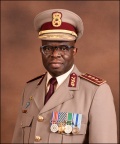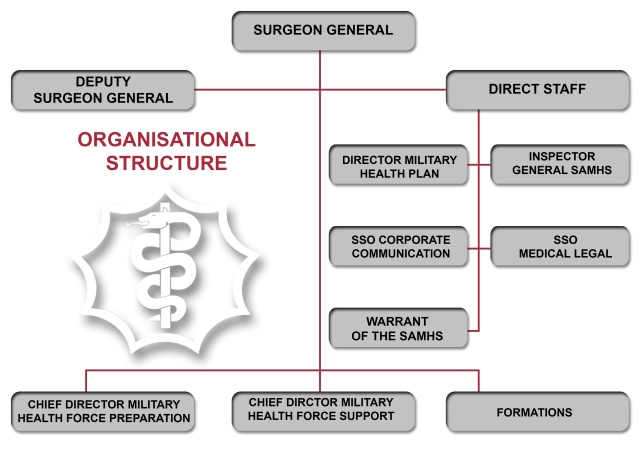
Almanac
South Africa, Republic of


Surgeon General
N.P. Maphaha
Lieutenant General Dr.
Source: Ministry of Defence South Africa
Office of the Surgeon General
Private Bag X 102
Centurion, 0046
SOUTH AFRICA
Pictures and Graphics: Wikimedia Commons
PROFILE OF LIEUTENANT GENERAL (DR) NTSHAVHENI PETER MAPHAHA, psc(j), ensp
Lieutenant General (Dr) Ntshavheni Peter Maphaha is the Surgeon General of the South African National Defence (SANDF) and the head of the South African Military Health Service (SAMHS) since November 2021. He was born in 1967, 8th August at Thohoyandou in Venda, Limpopo Province. He completed his Bachelor of Medicine and Surgery (MBchB) within prescribed period at Nelson Mandela Medical School, formerly known as University of Natal in 1990.
He also completed his functional courses namely; Advanced Trauma Life Support and Battle Advanced Trauma Life Support at 1 Military Hospital in 2001, Diving Medical Examiner at the University of Stellenbosch in 2008, Senior Management Programme at Tshwane University of Technology in 2006, Supply Chain Management at Department of Trade and Industry in 2007, Policy Writer`s Course at Defence Intelligence College in 2007 and Medical Strategic Leadership Programme at Fort Sam USA Army Medical Institution, Houston, Texas, in 2010.
For leadership and management in the SANDF, Lt Gen Maphaha completed military training such as Officers Formative in 1995, Medical Battle Handling (Platoon Commander’s course) in 1996, Junior Command and Staff in 2000, Senior Management Programme in 2005, Joint Senior Command and Staff Programme (JSCSP) in 2006 and Executive National Security Programme at National Defence College in 2010.
During his professional career, Lt Gen Maphaha has served the Republic of South Africa and National Defence Force in various capacities as follows:
• Chief Director Military Health Force Preparation (June 2020 to 01 November 2021).
• General Officer Commanding (CEO) 1 Military Hospital (2012 to 2020).
• Officer Commanding (Superintendent) 2 Military Hospital (2008 to 2011).
• Senior Staff Officer (Deputy Director) Communicable Diseases in the Director Medicine
Officer at South African Military Health Service Headquarters.
• Deployed in the DRC, as a member of the Air Evacuation Team for the UN Peace Mission
in that country (2002).
• Deployed in 1997 to Lesotho as a Medical Officer during peace enforcement by the
SA National Defence Force.
• Seconded to the United Nations as Force Medical Officer of United Nations Mission in Liberia (UNMIL) from 2003 to 2005 with responsibilities to establish, control and manage a medical support for all Forces in that peace mission.
Lt Gen Maphaha served as a Medical Officer at Tshilidzini Hospital in Thohoyandou from 1992 to 1994 and later joined the military as a Senior Medical Officer at Vuwani Sickbay (a Unit within Area Military Health Unit Limpopo from 1995 to 1997 and as a Medical Staff Officer in Area Military Health Unit Limpopo from 1998 to 2002.
He is passionate about health management in order to improve the health of all South Africans, specifically the military community. He is married with two children.
THE SOUTH AFRICAN MILITARY HEALTH SERVICE (SAMHS)
VISION
A Healthy Military Community.
MISSION
The Surgeon General's Mission for the SAMHS:
To support the SANDF by:
• providing health services for the full range of military deployments
(where and whenever needed), and
• sustaining the health of members of the armed forces, their families and others eligible for
care by the SAMHS
SLOGAN
“Towards Military Health Excellence”
VALUES
The outcome of shared values is the 'legitimacy' of the SAMHS in the Department of Defence and especially in the SANDF. The organisational culture of the SAMHS is described in the following 'A to I' shared values:
- Accountable - "Taking ownership for work and decisions made". The belief in one's own ability and judgment. The confidence to express ones' views in increasingly challenging circumstances to the benefit of the SAMHS. Getting the job done within the legislative and regulatory frameworks. Take action rather than to take note.
- Be Positive - "Focus on solutions, not only problems". The ability to identify what needs to be done and to develop appropriate plans of action to accomplish objectives. This entails the identification and prioritisation of key issues to ensure the efficient and effective implementation of the Annual Performance Plan. The monitoring of progress and early warning systems must be in place. The organising of resources must be performed.
- Client Centred - "See the SAMHS as the client does". The desire to anticipate, meet and exceed the needs and expectations of all clients. The SAMHS must be committed to client satisfaction and the fulfilling of client's expectations. Professionalism is demanded from all SAMHS members.
- Discipline as Cornerstone - The SAMHS will execute the initiatives of the C SANDF to instil and improve discipline in the SANDF.
- Energy and Synergy - "Unified in command". The interventions to address the unification of command and eliminate disjointedness. The SAMHS Opposing Forces versus Own Forces syndrome must be eliminated.
- Fight Criminality, Corruption and Fraud - Scarce resources must be protected.
- Generate Communication - Communication must be used to promote direction and allay insecurities.
- Honest Hard Work - "Work ethic of honest hard work". The drive to ensure that quality is not compromised and that standards are maintained and improved.
- Innovative thinking - "Drive for continuous improvement". Innovative Thinking is required in a changing environment. SAMHS has to realise that it is part of the ever-changing bigger picture. The ability of SAMHS to develop new and innovative ways of looking at processes, problems and thinking 'outside the box' must be evident. Innovative thinking is required in organisations that experience resource constraints.

Source: Ministry of Defence South Africa
(status: 21. February 2024)











